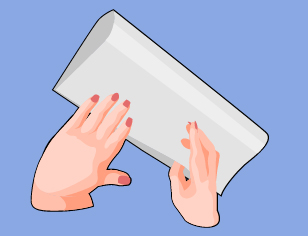Lesson 4
1. Lesson 4
1.4. Discover
Module 1: Sequences and Series
Discover
How many times can you fold a piece of paper in half? You will answer that question in this Math Lab. You will also learn something about another type of sequence.
Problem
Given a sheet of paper, how do the number of half-folds affect the number of layers?
Materials
You will need a sheet of paper.
Procedure
| Step 1: Construct a table similar to the table shown. |
|
|||||||||||||||
| Step 2: Measure the dimensions of the sheet of paper, and calculate the area. Record your answer in the third column of the table. |  |
|||||||||||||||
| Step 3: Fold the paper in half. In your table, record the area of the new rectangle formed and the number of layers of paper. |  |
|||||||||||||||
| Step 4: Repeat Step 3 as many times as possible. You will need to add several rows to your table. |
Analysis
- Identify, compare, and describe all the patterns you observe in the table.
- Develop a method to find the following values:
- the number of layers after the 16th fold
- the area of the rectangle after the 16th fold
- the number of folds required to have 16 384 layers
- the number of layers after the 16th fold
![]() Save your work in your course folder. You will use your notes later in the lesson.
Save your work in your course folder. You will use your notes later in the lesson.
Did You Know?
In 2002, high school student Britney Gallivan (of Pomona, California) folded a very long sheet of toilet paper in half 12 times. Prior to that, it was popularly held that no sheet of paper could be folded more than 7 times. The toilet paper measured approximately 1200 m in length! Britney also derived a formula that related the properties of a piece of paper to the maximum number of times the paper could be folded in half. Ms. Gallivan’s mathematical feat has been featured in television documentaries and even on an episode of the television show Numb3rs.